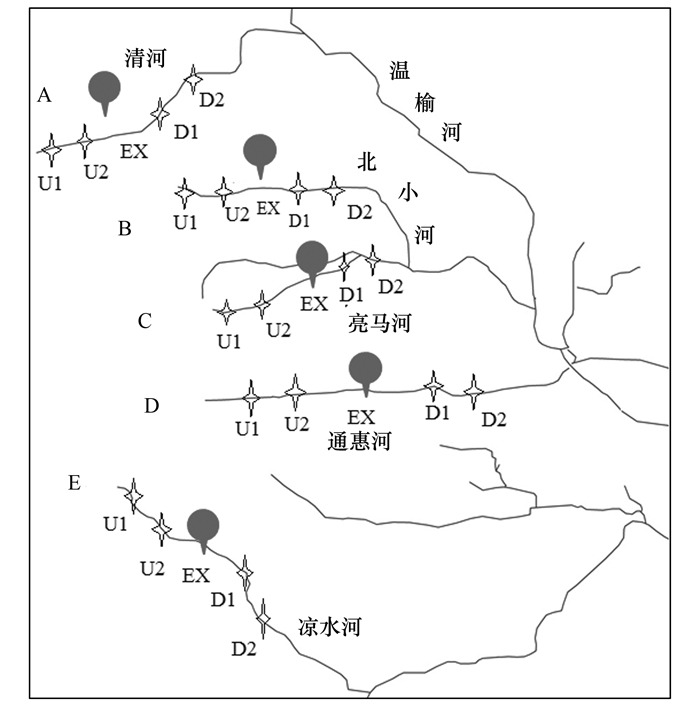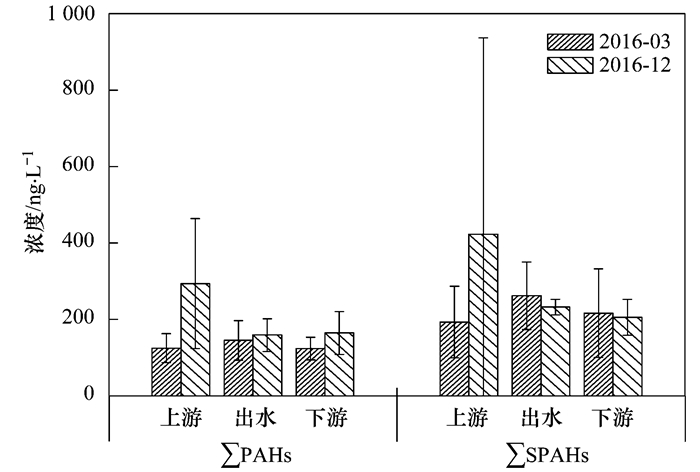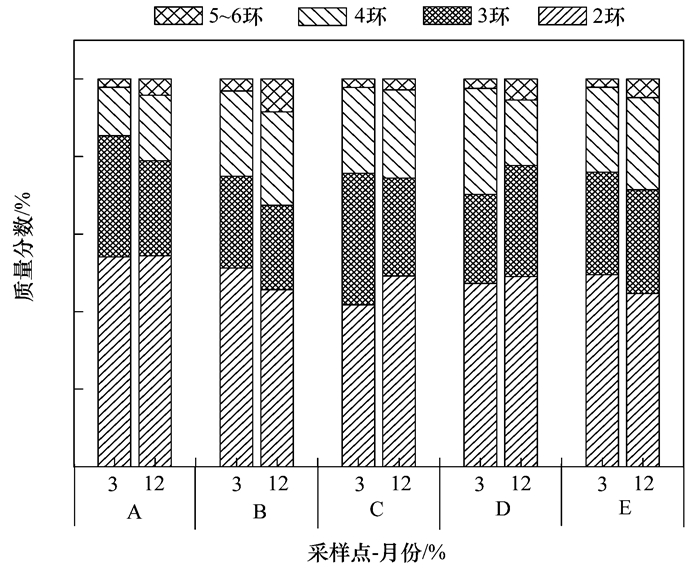2. 中国科学院生态环境研究中心环境水质学国家重点实验室, 北京 100085;
3. 清华大学新兴有机污染物控制北京市重点实验室, 北京 100084
2. State Key Laboratory of Environmental Aquatic Chemistry, Research Center for Eco-Environmental Sciences, Chinese Academy of Sciences, Beijing 100085, China;
3. Beijing Key Laboratory for Emerging Organic Contaminants Control, Tsinghua University, Beijing 100084, China
多环芳烃(polycyclic aromatic hydrocarbons, PAHs)是美国环保局规定的一类优先控制污染物, 具有致畸、致癌、致突变的作用, 在水、土壤、大气、沉积物等环境介质中广泛存在, 人们可以通过呼吸、饮食等多种途径摄入, 从而对人体健康产生潜在危害, 其带来的生态效应已引起国际社会的关注[1, 2]. PAHs可以通过化学或微生物作用转化成其衍生物(substituted polycyclic aromatic hydrocarbons, SPAHs), 如甲基、氧化、氯代等多环芳烃衍生物(MPAHs、OPAHs、ClPAHs)[3, 4]. SPAHs也可通过和PAHs同样的污染源排入到环境中, 如生活污水、工业废水等, 而SPAHs可能具有更强的毒性和“三致效应”[5].
我国对水中PAHs开展调查研究主要集中于大江大河或主要海域, 且主要是关于河流水体中PAHs的研究[6~14], 对SPAHs的研究甚少. 2009~2010年北京地区纳污河流中PAHs的质量浓度为190~1 790 ng·L-1; 北京通州地区河流中, PAHs质量浓度为90~1 890 ng·L-1; 北京市东郊河流中PAHs质量浓度为176~1 425 ng·L-1 [13~15]. Qiao等[16]在北京污水处理厂及纳污河流中检出MPAHs、OPAHs、ClPAHs这3类SPAHs, 并且指出污水处理厂二级出水是纳污河流中PAHs及SPAHs的主要来源, 其中PAHs质量浓度为89~474 ng·L-1, SPAHs质量浓度为61~529 ng·L-1; 曹巍等[17]对北京及广东4座污水处理厂中PAHs及SPAHs进行研究, 结果表明北京市3座污水处理厂的PAHs进水质量浓度为:430.7~490.1 ng·L-1, 广东D污水处理厂的PAHs质量浓度较低为281.1 ng·L-1.而SPAHs质量浓度比较平均为366.5~474.2 ng·L-1.由以上研究可知, 北京污水处理厂出水及受纳河流中存在SPAHs且质量浓度与PAHs相近, 需引起重视.目前对于北京污水处理厂出水受纳河流中SPAHs的污染状况未见报道, 基于此, 本文将针对北京5座典型污水处理厂出水及受纳河流中PAHs和SPAHs的质量浓度及组成开展研究, 明确污染物分布特征, 初步判断污染物的来源, 并进一步评价城市河流中PAHs对人体的健康风险, 以期为保证城市水体可持续发展提供基础数据和背景资料.
1 材料与方法 1.1 实验材料及仪器16种PAHs包括萘(Nap)、苊烯(Acy)、苊(Ace)、芴(Fluo)、菲(Phe)、蒽(Ant)、荧蒽(Flua)、芘(Pyr)、苯并[a]蒽(BaA)、(Chry)、苯并[b]荧蒽(BbF)、苯并[k]荧蒽(BkF)、苯并[a]芘(BaP)、茚并[1, 2, 3-cd]芘(IcdP)、二苯并[a, h]蒽(DBA)和苯并[g, h, i]苝(BghiP)的混合标准样品. 4种MPAHs包括2-甲基萘(2-MN)、1-甲基荧蒽(1-MF)、2, 6-二甲基萘(2, 6-DMN)和3, 6-二甲基菲(3, 6-DMP). 6种OPAHs包括9-芴酮(9-FL)、蒽酮(AT)、蒽醌(AQ)、2-甲基蒽醌(2-MAQ)、苯并蒽酮(BAT)和苯并蒽-7, 12-二酮(BA-7, 12-D). 9种ClPAHs分别为1-氯萘(1-CN)、2-氯萘(2-CN)、1, 4-二氯萘(DCN)、9-氯菲(9-ClPhe)、2-氯蒽(2-ClAnt)、1-氯蒽醌(1-ClAQ)、3-荧蒽(3-ClFlua)、1-氯芘(1-ClPyr)、6-氯苯芘(6-ClBap).回收率指示物为4种氘代多环芳烃:氘代苊(d-Ace)、氘代菲(d-Phe)、氘代
内标物质二氟联苯(2-FB)购于Aldrich ChemicalCo, Inc.(Gillingham, Dorset, USA). HPLC级正己烷、甲醇购于美国Fisher Scientific公司, 二氯甲烷购于美国J.T. Baker公司, 丙酮购于美国Dikma Technologies公司.无水硫酸钠(分析纯, 国药集团化学试剂有限公司), 使用前经马弗炉在450℃下煅烧, 以去除有机物.
1.2 样品采集及处理选择北京市5座典型市政污水厂出水及受纳河流:A、B、C、D和E为研究对象, 分别在每条河流污水厂出水口上游(U1、U2), 出水口(EX), 下游(D1、D2)布设5个监测断面, 相邻两点之间相距200m, 见图 1.河流样品用不锈钢采样器采集表层水, 污水厂出水样品在入河口采集, 均为瞬时样品. 2016年3月和12月各采样一次, 分别代表非取暖季和取暖季.

|
图 1 河流采样点分布示意 Fig. 1 River sampling locations |
水样采集后, 储存于4 L棕色玻璃瓶中, 运回实验室后, 用玻璃纤维滤膜(直径142 mm, 孔径0.7 μm, Millipore)过滤, 过滤后的样品用活化好的C18固相小柱(500 mg, 6 mL购于Supelco)在固相萃取装置上富集, 之后用10 mL DCM和5 mL HEX分4次洗脱萃取柱, 洗脱液用旋转蒸发仪旋转蒸发至1 mL左右, 然后转移到K-D浓缩瓶中, 用氮吹仪浓缩, 定容至0.5 mL.加入2-FB(100 ng), 以待进行仪器分析.由于颗粒相样品含量较低, 因此未做分析.
1.3 样品测定样品采用气相色谱-质谱仪进行测定(Agilent 5977B GC/MSD, 美国), 以无分流模式注入, 载气为氦气, 速度为1 mL·min-1.色谱条件:采用色谱柱为DB-5MS石英毛细管柱(30 m×0.25 mm×0.25 μm, J&W Co. USA); 离子源为电子轰击源(EI)[18].进样口温度280℃、测定温度为290℃; 升温程序:初始温度为60℃, 保留1 min, 以20℃·min-1升到110℃, 再以3℃·min-1升到290℃保留20 min.目标物首先以全扫描模式进行定性分析, 质荷比50~500, 扫描速率2 000 scan·s-1, 根据全扫描色谱图确定各目标物的保留时间, 根据质谱图及NIST谱库确定目标物的定性和定量离子.然后以选择离子扫描进行定量分析.
1.4 质量控制和质量保证标准曲线:不同质量浓度标线中加入相同量的内标, 以目标物峰面积和内标的比值建立8点标准曲线.以3倍和10倍信噪比分别作为方法检出限和定量限, 35种目标物的检出限为0.02~27.6 ng·L-1, 定量限为0.04~91.9 ng·L-1.样品中指示物回收率分别为:d-Ace, (91±17)%; d-Phe, (90±18)%; d-Chry, (91±18)%; d-Pery, (73±19)%.
2 结果与讨论 2.1 污水处理厂出水及纳污河流中∑PAHs及∑SPAHs的污染水平2016年3月和12月采集的样品中, ∑PAHs及∑SPAHs总质量浓度的平均值、最小值及最大值分别进行统计分析, 结果见表 1.污水处理厂出水及受纳河流中16种PAHs, IcdP与DBA未检出, 其他物质均可检出, 其中BkF、BaP和BghiP部分检出, 检出率分别为61%、51%和96%, 质量浓度较高的是Nap、Fluo和Phe. ∑PAHs质量浓度范围分别为:121~428、75~232、102~209、82~253和118~584 ng·L-1, 平均值分别为223、110、148、152和221 ng·L-1.与天津海河(174 ng·L-1)、深圳茅洲河(292 ng·L-1)、浙江钱塘江(283 ng·L-1)相差不大[6~8], 与黑龙江松花江(935 ng·L-1)、意大利的亚诺河(739 ng·L-1)相比含量较低[9, 10], 与广东西江(59 ng·L-1)、美国密西西比河(136 ng·L-1)相比含量较高[11, 12].
|
|
表 1 2016年3月和12月污水处理厂出水及受纳河流中∑PAHs和∑SPAHs质量浓度1)/ng·L-1 Table 1 Concentrations of ∑PAHs and ∑SPAHs in effluents from sewage treatment plants and receiving rivers in March and December 2016/ng·L-1 |
由图 2可知河流中PAHs质量浓度在12月明显高于3月, 采用SPSS 17.0统计分析软件对测得的PAHs数据进行配对t检验得到PAHs与季节有显著性差异(P < 0.05).水体中PAHs同分异构体的比值可指示其来源. Yunker等[19]认为Ant/(Ant+Phe)小于0.1, 主要是石油源, 大于0.1时, 主要为燃烧源. Flua/(Flua+Pyr)小于0.4为石油源, 0.4~0.5则为石油源和燃烧源的混合源, 大于0.5时为燃烧源. BaA/(BaA+Chry)<0.2为石油源, 0.2~0.35为混合源, 大于0.35为燃烧源.由表 2可知, 河流中PAHs主要来源于煤的燃烧, 石油源较少. 12月燃烧源所占质量分数高于3月, 主要是因为12月为北京冬季取暖期, 煤的不完全燃烧产生的PAHs高于非取暖季.

|
图 2 不同季节上下游及出水口∑PAHs及∑SPAHs质量浓度 Fig. 2 Concentration of ∑PAHs and ∑SPAHs in the upstream, downstream and effluent during different seasons |
|
|
表 2 2016年3月和12月污水受纳河流中PAHs同分异构体比值1) Table 2 Ratios of isomer PAH pairs in five typical effluents from sewage treatment plants and receiving rivers in March 2016 |
污水处理厂出水及受纳河流A、B、C、D和E中SPAHs总质量浓度范围分别为154~326、91~243、145~1822、151~316和229~528 ng·L-1.平均值分别为213、163、383、213和310 ng·L-1.采用SPSS 17.0统计分析软件在P=0.05的置信水平对测得的SPAHs数据进行单因素方差分析, 结果表明E中SPAHs质量浓度显著高于A、B及D(P < 0.05). E中2-MN、3, 6-DMP、AT及AQ质量浓度较高.据北京市环保局报道E上游有染料废水直接排放, 染料废水是AQ和AT的主要直接来源之一, 因此导致E中SPAHs总质量浓度高.由图 2可知出水口及河流下游3月SPAHs含量高于12月, SPAHs除了直接排放, 还可能存在母体PAHs向SPAHs转化的光化学和微生物过程, 可能在太阳辐射较强和温度较高的非取暖期更容易发生[20]. C中, 12月上游SPAHs含量远高于其它河流(1 822 ng·L-1), 主要为AT、AQ的贡献. C上游采样点附近有一垃圾中转站, 垃圾渗滤液污染有机成分复杂, 包括羧酸类、醛及酮类、芳烃类等有机化合物[21], C上游12月质量浓度高可能是由于垃圾渗滤液的偶然排放.
2.2 污水处理厂出水及受纳河流中PAHs及SPAHs的分布特征污水处理厂出水及受纳河流中2环(Nap、Acy、Ace和Fluo)与3环PAHs(Phe、Ant和Flua)所占质量分数较大, 分别为48%和26%(图 3).其中Nap的质量浓度最高, 主要是因为Nap常作为樟脑球的主要原材料而被人们日常生活广泛应用[9].其次为4环PAHs(Pyr、BaA、Chry、BbF和BkF, 21%), 5~6环所占比例较低(BaP、IncdP、DBA和BghiP, 4%).深圳的茅洲河和非洲北部的突尼斯海湾[7, 22]中均以低分子量的PAHs为主, 这与PAHs的物理化学性质有关, PAHs属于疏水性有机物, 在水中溶解度小.

|
图 3 污水受纳河流及出水中PAHs分布特征 Fig. 3 Distribution of PAHs in effluents from sewage treatment plants and receiving rivers |
根据目标物的不同取代基, 将SPAHs分为MPAHs、OPAHs和ClPAHs.由图 4(a)可知OPAHs所占比例较高, 为75%, MPAHs、ClPAHs总体较低, 占比分别为12%、13%.这是由于OPAHs极性较强, 在水中的溶解度较大.此外, OPAHs容易由PAHs转化生成[18, 23].在本研究中AT和BAT部分检出, 检出率为67%、92%, 其他物质均100%检出, 其中对OPAHs贡献率最高的为AT(27%)和AQ[24%, 图 4(b)]. MPAHs中2-MN所占质量分数最大[79%, 图 4(c)], 2, 6-DMN、1-MF和3, 6-DMP所占质量分数次之(11%、8%和2%), 检出率依次为100%、100%、55%和96%.由此可见, MPAHs的质量浓度随芳环数增加而减小, 随甲基取代个数的增加而减小[24].水中ClPAHs质量浓度与PAHs相比较低, 这与大气环境中的PAHs研究结果一致, 环境中ClPAHs的排放量较少[25]. ClPAHs中DCN所占质量分数最大[40%, 图 4(d)], 其次是2-ClAnt、1-ClAQ、1-ClPyr、2-CN、1-CN、3-ClFlua(27%、17%、7%、4%、3%和2%).检出率分别为96%、82%、33%、100%、100%、76%和80%, 9-ClPhe, 6-ClBap均低于检出限.

|
图 4 污水受纳河流及出水中3种SPAHs所占比例 Fig. 4 Proportion of SPAHs in effluents from sewage treatment plants and receiving rivers |
2~3环PAHs具有急性毒性, 而4~6环PAHs则具有潜在的致癌性[26]. Nisbet等[27]提出毒性当量因子(TEFs)的概念, 并用来分析环境中PAHs的生态风险. TEFs被广泛应用, 其中BaP和DBA为1, BaA、BbF、BkF及IcdP为0.1, Ant、Chry、Bghip为0.01, 其余为0.001[28].根据TEFs值可以计算水中16种典型PAHs相对BaP的毒性当量TEQBaP, 公式为:

|
本研究中, 污水处理厂出水及受纳河流中PAHs的TEQs和∑TEQs量见表 3.结果显示, 7种强致癌性PAHs对∑TEQBaP有较大贡献, 占比为96%. 5条河流中PAHs的TEQBaP范围(以BaPeq计)为:0~2.75 ng·L-1(3月)、0~11.40 ng·L-1(12月), 平均值为3.87 ng·L-1(3月)、11.41 ng·L-1(12月), 其中BaP在5条河流中均高于2.由表 3可知∑TEQBaP在不同河流中相差不大, 但在不同季度差异显著, 因此应当在采暖季(12月)对高环PAHs污染引起重视.
|
|
表 3 不同污水处理厂出水及受纳河流中PAHs的TEQ浓度(以BaPeq计)1)/ng·L-1 Table 3 PAHs TEQ concentration in different sewage treatment plants and receiving rivers(BaPeq)/ng·L-1 |
3 结论
PAHs和SPAHs在北京污水受纳河流及出水中部分检出, ∑PAHs和∑SPAHs质量浓度分别为75~584 ng·L-1和91~1 822 ng·L-1.河流中PAHs主要来源为燃烧源, 故采暖季PAHs质量浓度高于非采暖季, 染料废水和垃圾渗滤液可能是SPAHs污染的来源之一.水样中PAHs以2~3环为主(23%~48%).高分子量PAHs主要为4环(13%~27%), 而5~6环的较少(2%~8%).水样中SPAHs以OPAHs为主, 占75%, MPAHs和ClPAHs所占质量分数较低(12%和13%).通过对5条河流中PAHs的TEQBaP计算, 表明高环PAHs污染应当在采暖季(12月)引起重视.
| [1] | Wania F, MacKay D. Peer reviewed:tracking the distribution of persistent organic pollutants[J]. Environmental Science & Technology, 1996, 30(9): 390A-396A. |
| [2] | Dimashki M, Lim L H, Harrison R M, et al. Temporal trends, temperature dependence, and relative reactivity of atmospheric polycyclic aromatic hydrocarbons[J]. Environmental Science & Technology, 2001, 35(11): 2264-2267. |
| [3] | Lee H B, Peart T E, Hong-You R L, et al. Supercritical carbon dioxide extraction of polycyclic aromatic hydrocarbons from sediments[J]. Journal of Chromatography A, 1993, 653(1): 83-91. DOI:10.1016/0021-9673(93)80394-N |
| [4] | Ohura T, Amagai T, Makino M. Behavior and prediction of photochemical degradation of chlorinated polycyclic aromatic hydrocarbons in cyclohexane[J]. Chemosphere, 2008, 70(11): 2110-2117. DOI:10.1016/j.chemosphere.2007.08.064 |
| [5] | Blanchard M, Teil M J, Ollivon D, et al. Polycyclic aromatic hydrocarbons and polychlorobiphenyls in wastewaters and sewage sludges from the Paris area (France)[J]. Environmental Research, 2004, 95(2): 184-197. DOI:10.1016/j.envres.2003.07.003 |
| [6] | Shi Z, Tao S, Pan B, et al. Contamination of rivers in Tianjin, China by polycyclic aromatic hydrocarbons[J]. Environmental Pollution, 2005, 134(1): 97-111. |
| [7] | Zhang D, Wang J J, Ni H G, et al. Spatial-temporal and multi-media variations of polycyclic aromatic hydrocarbons in a highly urbanized river from South China[J]. Science of the Total Environment, 2017, 581-582: 621-628. DOI:10.1016/j.scitotenv.2016.12.171 |
| [8] | Chen Y Y, Zhu L Z, Zhou R B. Characterization and distribution of polycyclic aromatic hydrocarbon in surface water and sediment from Qiantang River, China[J]. Journal of Hazardous Materials, 2007, 141(1): 148-155. DOI:10.1016/j.jhazmat.2006.06.106 |
| [9] | Zhao X S, Ding J, You H. Spatial distribution and temporal trends of polycyclic aromatic hydrocarbons (PAHs) in water and sediment from Songhua River, China[J]. Environmental Geochemistry and Health, 2014, 36(1): 131-143. DOI:10.1007/s10653-013-9524-0 |
| [10] | Montuori P, Triassi M. Polycyclic aromatic hydrocarbons loads into the Mediterranean Sea:estimate of Sarno River inputs[J]. Marine Pollution Bulletin, 2012, 64(3): 512-520. DOI:10.1016/j.marpolbul.2012.01.003 |
| [11] | Deng H M, Peng P A, Huang W L, et al. Distribution and loadings of polycyclic aromatic hydrocarbons in the Xijiang River in Guangdong, South China[J]. Chemosphere, 2006, 64(8): 1401-1411. DOI:10.1016/j.chemosphere.2005.12.027 |
| [12] | Mitra S, Bianchi T S. A preliminary assessment of polycyclic aromatic hydrocarbon distributions in the lower Mississippi River and Gulf of Mexico[J]. Marine Chemistry, 2003, 82(3-4): 273-288. DOI:10.1016/S0304-4203(03)00074-4 |
| [13] | Qi W X, Liu H J, Pernet-Coudrier B, et al. Polycyclic aromatic hydrocarbons in wastewater, WWTPs effluents and in the recipient waters of Beijing, China[J]. Environmental Science and Pollution Research, 2013, 20(6): 4254-4260. DOI:10.1007/s11356-012-1435-6 |
| [14] | Shen Q, Wang K Y, Zhang W, et al. Characterization and sources of PAHs in an urban river system in Beijing, China[J]. Environmental Geochemistry and Health, 2009, 31(4): 453-462. DOI:10.1007/s10653-008-9198-1 |
| [15] |
曲洁婷, 卢少勇, 张建, 等. 北京市东郊河流水中多环芳烃的分布[J]. 环境科学与技术, 2014, 37(S2): 161-165. Qu J T, Lu S Y, Zhang J, et al. Studies on distribution of PAHs in urban river water of Beijing[J]. Environmental Science & Technology, 2014, 37(S2): 161-165. |
| [16] | Qiao M, Cao W, Liu B H, et al. Impact of upgrading wastewater treatment plant on the removal of typical methyl, oxygenated, chlorinated and parent polycyclic aromatic hydrocarbons[J]. Science of the Total Environment, 2017, 603-604: 140-147. DOI:10.1016/j.scitotenv.2017.06.097 |
| [17] |
曹巍, 乔梦, 张一心, 等. 典型污水处理厂对多环芳烃及其衍生物的去除及再生水健康风险研究[J]. 生态毒理学报, 2016, 11(3): 173-179. Cao W, Qiao M, Zhang Y X, et al. Removal of parent and substituted polycyclic aromatic hydrocarbons in typical wastewater treatment plants and health risk assessment of re-claimed water[J]. Asian Journal of Ecotoxicology, 2016, 11(3): 173-179. |
| [18] | Qiao M, Qi W X, Liu H J, et al. Simultaneous determination of typical substituted and parent polycyclic aromatic hydrocarbons in water and solid matrix by gas chromatography-mass spectrometry[J]. Journal of Chromatography A, 2013, 1291: 129-136. DOI:10.1016/j.chroma.2013.03.044 |
| [19] | Yunker M B, Macdonald R W, Vingarzan R, et al. PAHs in the Fraser River basin:a critical appraisal of PAH ratios as indicators of PAH source and composition[J]. Organic Geochemistry, 2002, 33(4): 489-515. DOI:10.1016/S0146-6380(02)00002-5 |
| [20] | Qiao M, Qi W X, Liu H J, et al. Occurrence, behavior and removal of typical substituted and parent polycyclic aromatic hydrocarbons in a biological wastewater treatment plant[J]. Water Research, 2014, 52: 11-19. DOI:10.1016/j.watres.2013.12.032 |
| [21] | 夏昌伟. 垃圾渗滤液中有机污染物成分特征的研究进展[J]. 现代农业科技, 2016(6): 194, 206. |
| [22] | Mzoughi N, Chouba L. Distribution and partitioning of aliphatic hydrocarbons and polycyclic aromatic hydrocarbons between water, suspended particulate matter, and sediment in harbours of the West coastal of the Gulf of Tunis (Tunisia)[J]. Journal of Environmental Monitoring, 2011, 13(3): 689-698. DOI:10.1039/c0em00616e |
| [23] | Lundstedt S, White P A, Lemieux C L, et al. Sources, fate, and toxic hazards of oxygenated polycyclic aromatic hydrocarbons (PAHs) at PAH-contaminated sites[J]. AMBIO:A Journal of the Human Environment, 2007, 36(6): 475-485. DOI:10.1579/0044-7447(2007)36[475:SFATHO]2.0.CO;2 |
| [24] |
乔梦, 齐维晓, 赵旭, 等. 多环芳烃及其衍生物在北京典型污水处理厂中的存在及去除[J]. 环境科学, 2016, 37(4): 1451-1459. Qiao M, Qi W X, Zhao X, et al. Occurrence and removal of polycyclic aromatic hydrocarbons and their derivatives in typical wastewater treatment plants in Beijing[J]. Environmental Science, 2016, 37(4): 1451-1459. |
| [25] | Ishaq R, Näf C, Zebühr Y, et al. PCBs, PCNs, PCDD/Fs, PAHs and Cl-PAHs in air and water particulate samples——patterns and variations[J]. Chemosphere, 2003, 50(9): 1131-1150. DOI:10.1016/S0045-6535(02)00701-4 |
| [26] | Witt G. Polycyclic aromatic hydrocarbons in water and sediment of the Baltic Sea[J]. Marine Pollution Bulletin, 1995, 31(4-12): 237-248. DOI:10.1016/0025-326X(95)00174-L |
| [27] | Nisbet I C T, LaGoy P K. Toxic equivalency factors (TEFs) for polycyclic aromatic hydrocarbons (PAHs)[J]. Regulatory Toxicology and Pharmacology, 1992, 16(3): 290-300. DOI:10.1016/0273-2300(92)90009-X |
| [28] | USEPA. Guidelines for carcinogen risk assessment[R]. Washington DC: Risk Assessment Forum USEPA, 2005. |
 2019, Vol. 40
2019, Vol. 40


